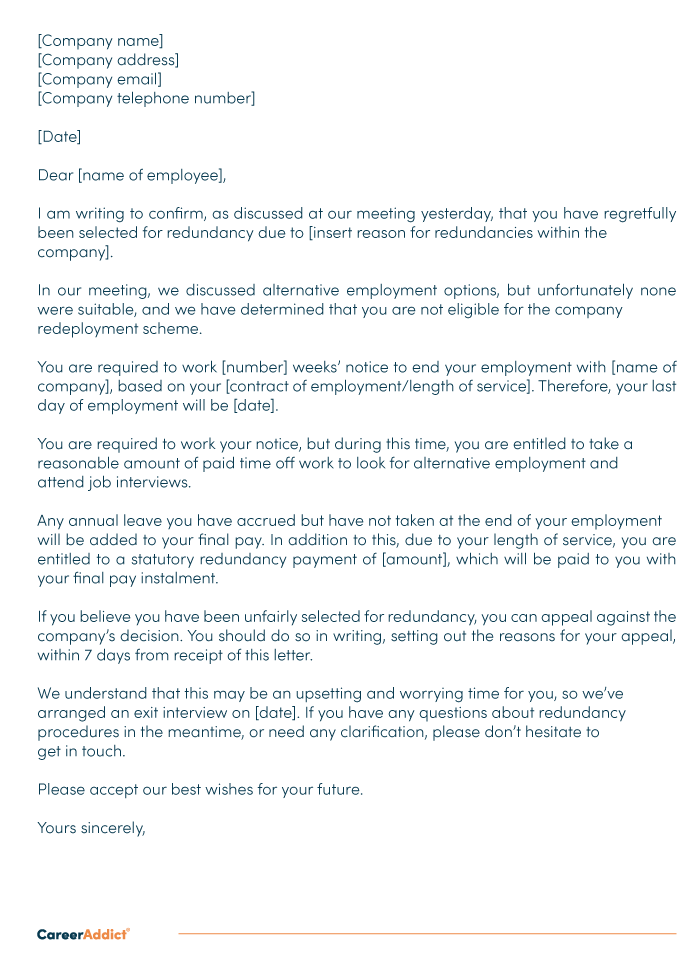If a Company Goes Bust Who Pays Redundancy? Lawful Insights for UK Employees
If a Company Goes Bust Who Pays Redundancy? Lawful Insights for UK Employees
Blog Article
Checking Out the Interplay In Between Company Redundancy and Business Versatility for Future Development
In the vibrant landscape of today's organization world, the complex relationship in between company redundancy and organizational versatility arises as an essential aspect for continual development and success. Companies typically deal with the obstacle of striking a fragile equilibrium between maintaining a level of redundancy to reduce dangers and cultivating flexibility to react promptly to the ever-evolving market needs.
Importance of Company Redundancy
Company redundancy is an important aspect that improves business durability and minimizes functional threats. By including redundancy actions within the business structure, firms can much better hold up against unpredicted disturbances and variations in the business environment. Redundancy works as a critical barrier, permitting companies to adjust and react successfully to unforeseen difficulties without compromising important operations.
One trick facet of the value of business redundancy is its role in ensuring connection throughout times of dilemma. When confronted with abrupt adjustments or emergencies, redundant systems, sources, or workers can action in to keep critical functions and avoid widespread disturbances. This continuity not only safeguards the firm's credibility and customer trust fund however also decreases monetary losses and operational downtime.

Techniques for Organizational Versatility

An additional crucial technique is buying innovation and infrastructure that can support versatility and scalability. Applying electronic devices, automation, and information analytics can streamline operations, enhance effectiveness, and supply beneficial understandings for educated decision-making. Moreover, creating adaptable organizational structures that permit quick adjustments to market dynamics and customer needs is important for staying competitive in a rapidly evolving environment. By proactively identifying potential disturbances and possibilities, companies can proactively prosper and adapt in an ever-changing service landscape.
Harmonizing Redundancy and Flexibility
Accomplishing a harmonious stability between operational redundancy and business versatility is paramount in browsing the complexities of a dynamic service atmosphere. Redundancy within a company look at this now provides a safeguard, making certain connection and stability in procedures. Nevertheless, an excess of redundancy can bring about ineffectiveness and hinder flexibility to changing market problems. On the other hand, business adaptability permits firms to react promptly to exterior disruptions and take new chances. Striking the right balance in between redundancy and adaptability is a fragile process that needs a deep understanding of the company's goals, market characteristics, and danger resistance.
To attain this equilibrium, firms require to conduct regular assessments of their operations to identify areas where redundancy is required for danger mitigation and where versatility can drive advancement and growth. Carrying out versatile structures, promoting a culture of continuous knowing and enhancement, and encouraging open communication across all levels of the company are vital approaches to integrate redundancy and versatility successfully. By lining up these two vital elements, companies can position themselves for lasting development and success in an ever-changing service landscape.
Study on Adaptation Success
In taking a look at instances of successful business adaptation, it becomes apparent that the interaction between operational redundancy and adaptability is a defining aspect in forming resistant businesses. A DVD rental service, Netflix demonstrated amazing versatility by transitioning into a streaming platform when digitalization interrupted the market. These situation research studies highlight the value of functional redundancy paired with business flexibility in cultivating lasting development and competition.
Building Durability for Future Growth
Building resilience for future development requires a critical positioning of operational procedures with market dynamics and arising trends. Firms need to adapt to transforming environments by cultivating a culture of adaptability, advancement, and continuous renovation.
Furthermore, fostering strong partnerships with stakeholders, such as clients, employees, vendors, and the community, is essential for preserving and weathering unpredictabilities count on and assistance during stormy times. Effective interaction and transparency play a crucial duty in building durability, as they aid straighten assumptions my review here and facilitate collaboration in browsing unpredictabilities.
Furthermore, organizations require to focus on learning and advancement efforts websites to upskill staff members and equip them with the required devices to adjust to transforming situations. By buying their labor force, firms can boost their adaptability and agility, eventually reinforcing their strength for lasting future growth.
Conclusion

In the vibrant landscape of today's service world, the complex relationship in between firm redundancy and organizational versatility arises as an important aspect for sustained growth and success. Companies usually encounter the difficulty of striking a delicate balance between keeping a level of redundancy to minimize threats and fostering adaptability to react promptly to the ever-evolving market demands.To attain this balance, companies need to carry out normal analyses of their procedures to identify locations where redundancy is essential for risk mitigation and where versatility can drive technology and growth.In conclusion, the interplay between business redundancy and business flexibility is crucial for future growth. Building resilience through a combination of redundancy and versatility will certainly make sure that firms are prepared for the obstacles of the future.
Report this page